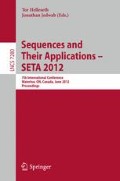Abstract
In this paper, we apply shift sequences defined by difference balanced function with d-form property to construct (almost) perfect or odd perfect sequences, which is a generalization of the construction given by Krengel in 2004. We then propose new signal sets with flexible parameters and zero odd periodic correlation zone or low odd periodic correlation zone property, by interleaving an odd perfect sequence or a sequence with low odd periodic correlation. Furthermore, we show that the parameters of some constructed signal sets are optimal with respect to the odd periodic correlation bound.
Access this chapter
Tax calculation will be finalised at checkout
Purchases are for personal use only
Preview
Unable to display preview. Download preview PDF.
References
Antweiler, M.: Cross-Correlation of p-ary GMW Sequences. IEEE Trans. Inform. Theory 40(4), 1253–1261 (1994)
Chung, J.-H., Yang, K.: New design of quaternary low-correlation zone sequence sets and quaternary hadamard matrices. IEEE Trans. Inform. Theory 54(8), 3733–3737 (2008)
Fan, P.Z., Suehiro, N., Kuroyanagi, N., Deng, X.M.: Class of binary sequences with zero correlation zone. Electronics Letters 35(10), 777–779 (1999)
Golomb, S.W., Gong, G.: Signal Design for Good Correlation: for Wireless Communication, Cryptography and Radar. Cambridge University Press, Cambridge (2005)
Gong, G.: Theory and applications of q-ary interleaved sequences. IEEE Trans. Inform. Theory 41(2), 400–411 (1995)
Gong, G., Golomb, S.W., Song, H.-Y.: A note on low-correlation zone signal sets. IEEE Trans. Inform. Theory 53(7), 2575–2581 (2007)
Gaudenzi, R.D., Elia, C., Viola, R.: Bandlimited quasisynchronous CDMA: A novel satellite access technique for mobile and personal communication systems. IEEE J. Sel. Areas Commun. 10(2), 328–343 (1992)
Hayashi, T.: A class of ternary sequence sets with a zero-correlation zone for periodic, aperiodic, and odd correlation functions. IEICE Trans. Fundamentals E86-A(7), 1850–1857 (2003)
Hayashi, T.: Zero correlation zone sequence set constructed from a perfect sequence. IEICE Trans. Fundamentals E90-A(5), 1–5 (2007)
Hayashi, T.: Ternary sequence set having periodic and aperiodic zero-correlation zone. IEICE Trans. Fundamentals E89-A(6), 1825–1831 (2006)
Helleseth, T., Gong, G.: New binary sequences with ideal-level autocorrelation function. IEEE Trans. Inform. Theory 154(18), 2868–2872 (2002)
Hu, H.G., Gong, G.: New sets of zero or low correlation correlation zone via interleaving techniques. IEEE Trans. Inform. Theory 56(4), 1702–1713 (2010)
Jang, J.-W., No, J.-S., Chung, H., Tang, X.H.: New sets of optimal p-ary low-correlation zone sequences. IEEE Trans. Inform. Theory 53(2), 815–821 (2007)
No, J.-S.: New cyclic diffrence sets with Singer parameters constructed from d-homogeneous function. Des., Codes, Cryptogr. 33, 199–213 (2004)
Klapper, A.: d-form sequence: Families of sequences with low correlaltion values and large linear spans. IEEE Trans. Inform. Theory 51(4), 1469–1477 (1995)
Krengel, E.I.: Almost-Perfect and Odd-Perfect Ternary Sequences. In: Helleseth, T., Sarwate, D., Song, H.-Y., Yang, K. (eds.) SETA 2004. LNCS, vol. 3486, pp. 197–207. Springer, Heidelberg (2005)
Krengel, E.I.: Some Constructions of Almost-Perfect, Odd-Perfect and Perfect Polyphase and Almost-Polyphase Sequences. In: Carlet, C., Pott, A. (eds.) SETA 2010. LNCS, vol. 6338, pp. 387–398. Springer, Heidelberg (2010)
Lüke, H.D., Schotten, H.D.: Odd-perfect almost binary correlation sequences. IEEE Trans. Aerosp. Electron. Syst. 31, 495–498 (1995)
Lüke, H.D.: Sets of ternary sequences with odd periodic zero correlation zones. Frequenz. 58, 214–216 (2004)
Lüke, H.D., Schotten, H.D.: Binary and quadriphase sequence with optimal autocorrelation: A survey. IEEE Trans. Inform. Theory 49(12), 3271–3282 (2003)
Parker, M.G.: Even Length Binary Sequence Families with Low Negaperiodic Autocorrelation. In: Boztaş, S., Sphparlinski, I.E. (eds.) AAECC 2001. LNCS, vol. 2227, pp. 200–209. Springer, Heidelberg (2001)
Popovic, B.M., Mauritz, O.: Generalized Chirp-like sequences with zero correlation zone. IEEE Trans. Inform. Theory 56(6), 2957–2960 (2010)
Tang, X.H., Fan, P.Z., Matsufuji, S.: Lower bounds on the maximum correlation of sequence set with low or zero correlation zone. Electron. Lett. 36(6), 551–552 (2000)
Tang, X.H., Fan, P.Z.: Bounds on aperiodic and odd correlation with low or zero correlation zone. Electron. Lett. 37(19), 1201–1203 (2001)
Tang, X.H., Fan, P.Z.: A class of pseudonise sequences over GF(p) with low correlation zone. IEEE Trans. Infrom. Theory 47(4), 1644–1649 (2001)
Tang, X.H., Mow, W.H.: A new systematic construction of zero correlation zone sequences based on interleaved perfect sequences. IEEE Trans. Inform. Theory 54(12), 5729–5735 (2008)
Suehiro, N.: Approximately synchronized CDMA system without cochannel using pseudo-periodic sequences. In: Proceedings of 1993 International Symposium on Personal Communications, Nanjing, China, pp. 179–184 (October 1994)
Tang, X.H.: A note on d-form function with differencebalanced property (preprint)
Zhou, Z.C., Tang, X.H., Gong, G.: A new class of sequences with zero or low correlation zone based on interleaving technique. IEEE Trans. Inform. Theory 54(9), 4267–4273 (2008)
Author information
Authors and Affiliations
Editor information
Editors and Affiliations
Rights and permissions
Copyright information
© 2012 Springer-Verlag Berlin Heidelberg
About this paper
Cite this paper
Yang, Y., Gong, G., Tang, X. (2012). Odd Perfect Sequences and Sets of Spreading Sequences with Zero or Low Odd Periodic Correlation Zone. In: Helleseth, T., Jedwab, J. (eds) Sequences and Their Applications – SETA 2012. SETA 2012. Lecture Notes in Computer Science, vol 7280. Springer, Berlin, Heidelberg. https://doi.org/10.1007/978-3-642-30615-0_1
Download citation
DOI: https://doi.org/10.1007/978-3-642-30615-0_1
Publisher Name: Springer, Berlin, Heidelberg
Print ISBN: 978-3-642-30614-3
Online ISBN: 978-3-642-30615-0
eBook Packages: Computer ScienceComputer Science (R0)

